Charles E W Bean, Diaries, AWM38 3DRL 606/254/1 - 1917 - 1933 - Part 1
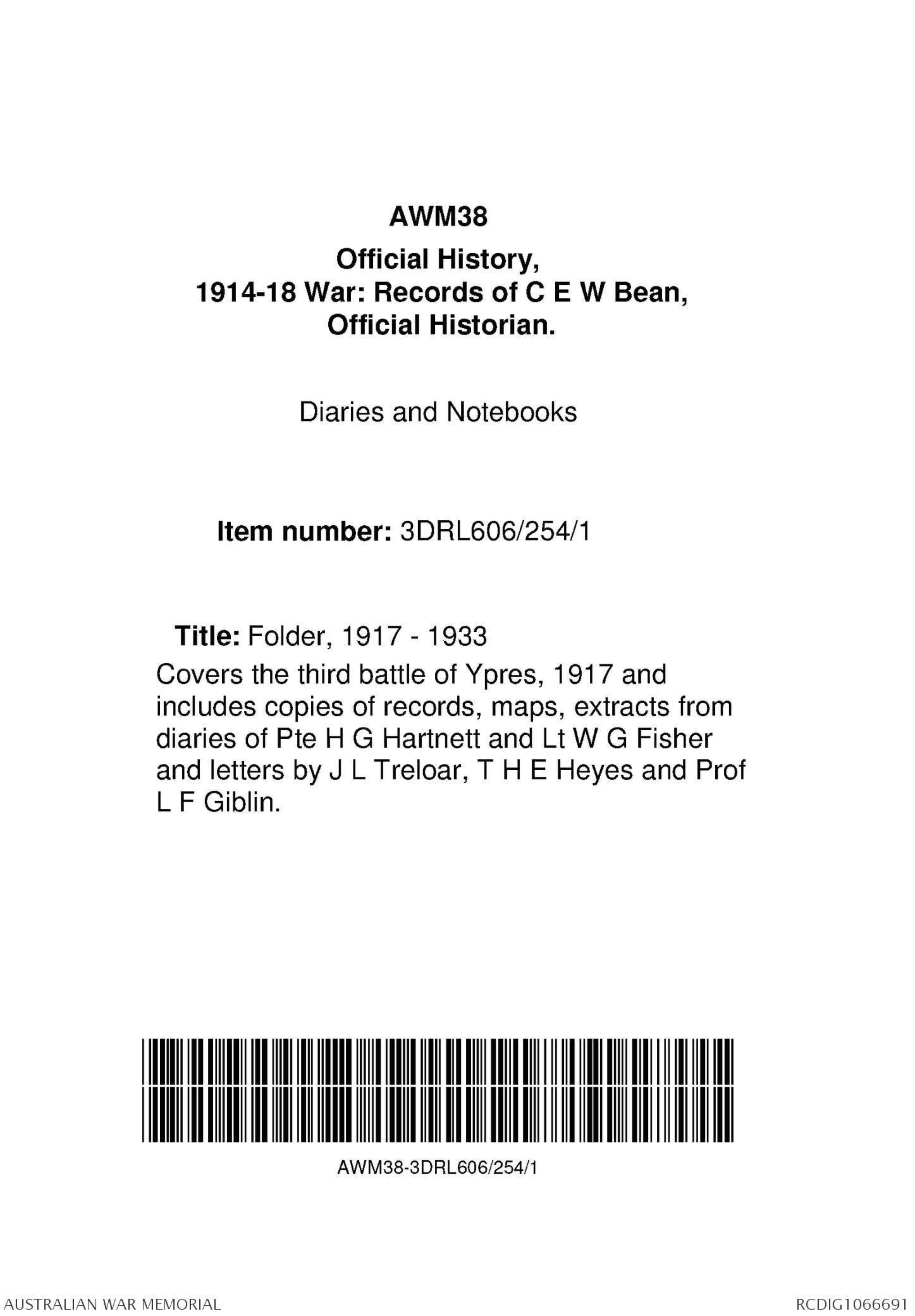
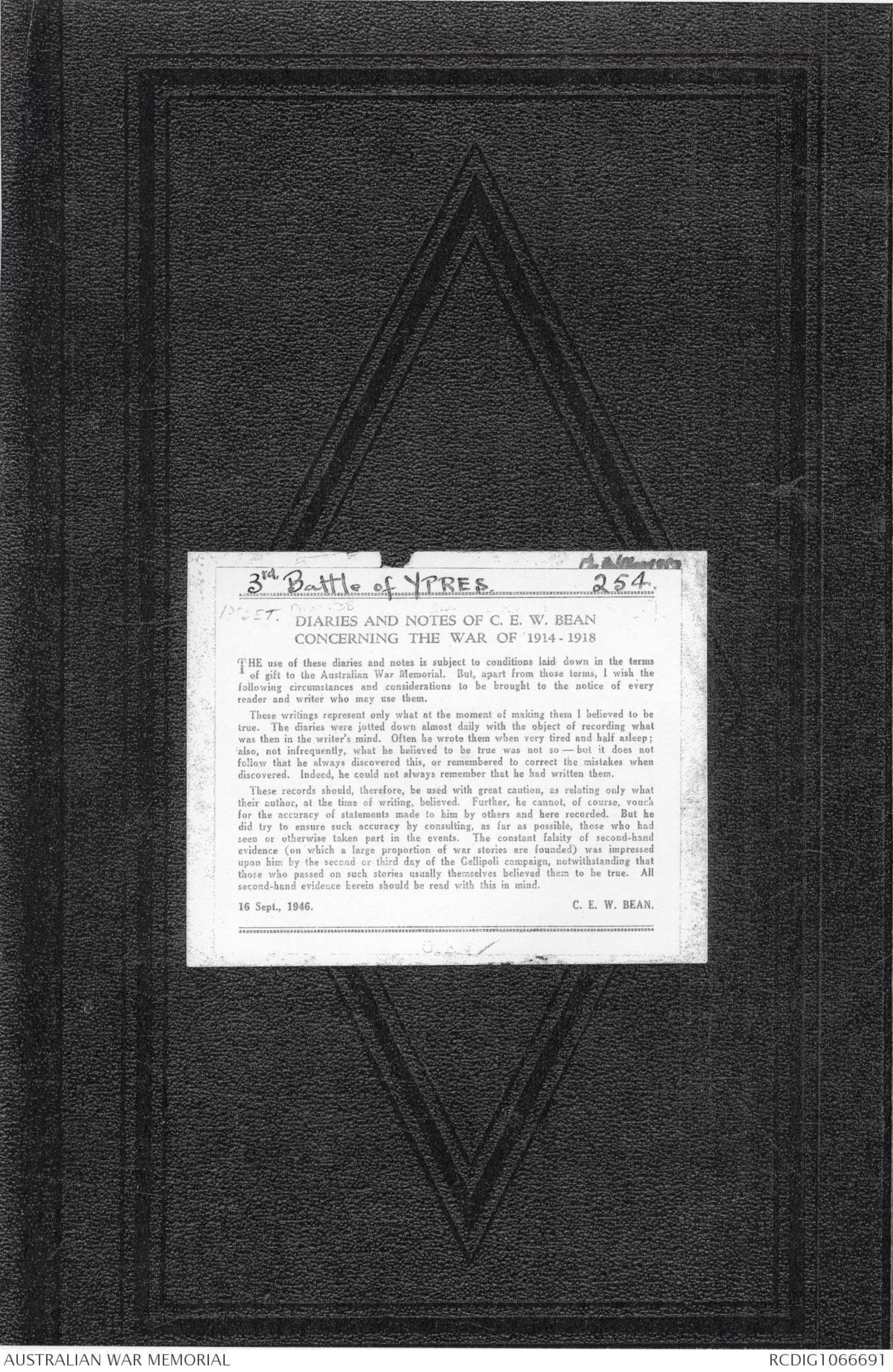
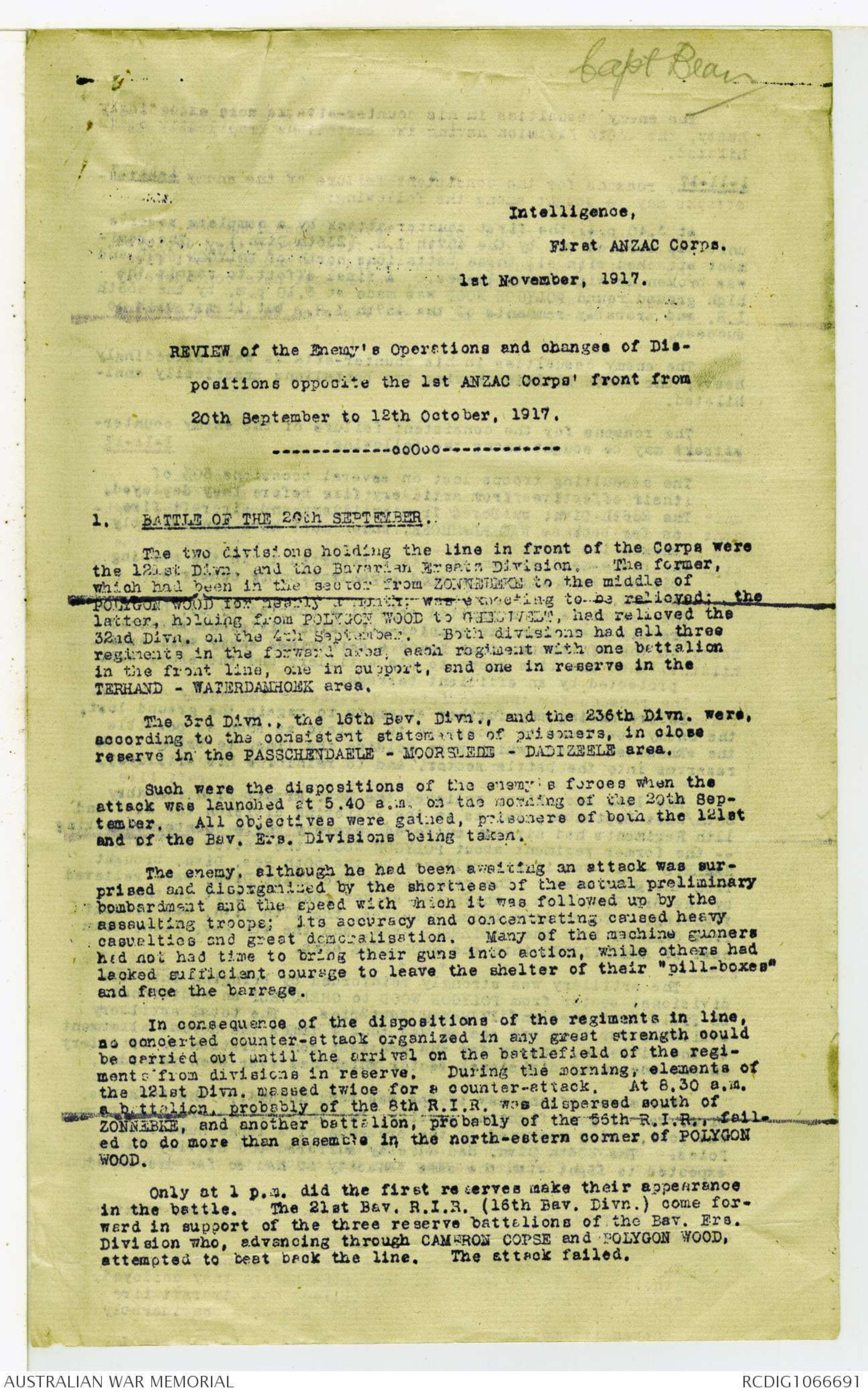
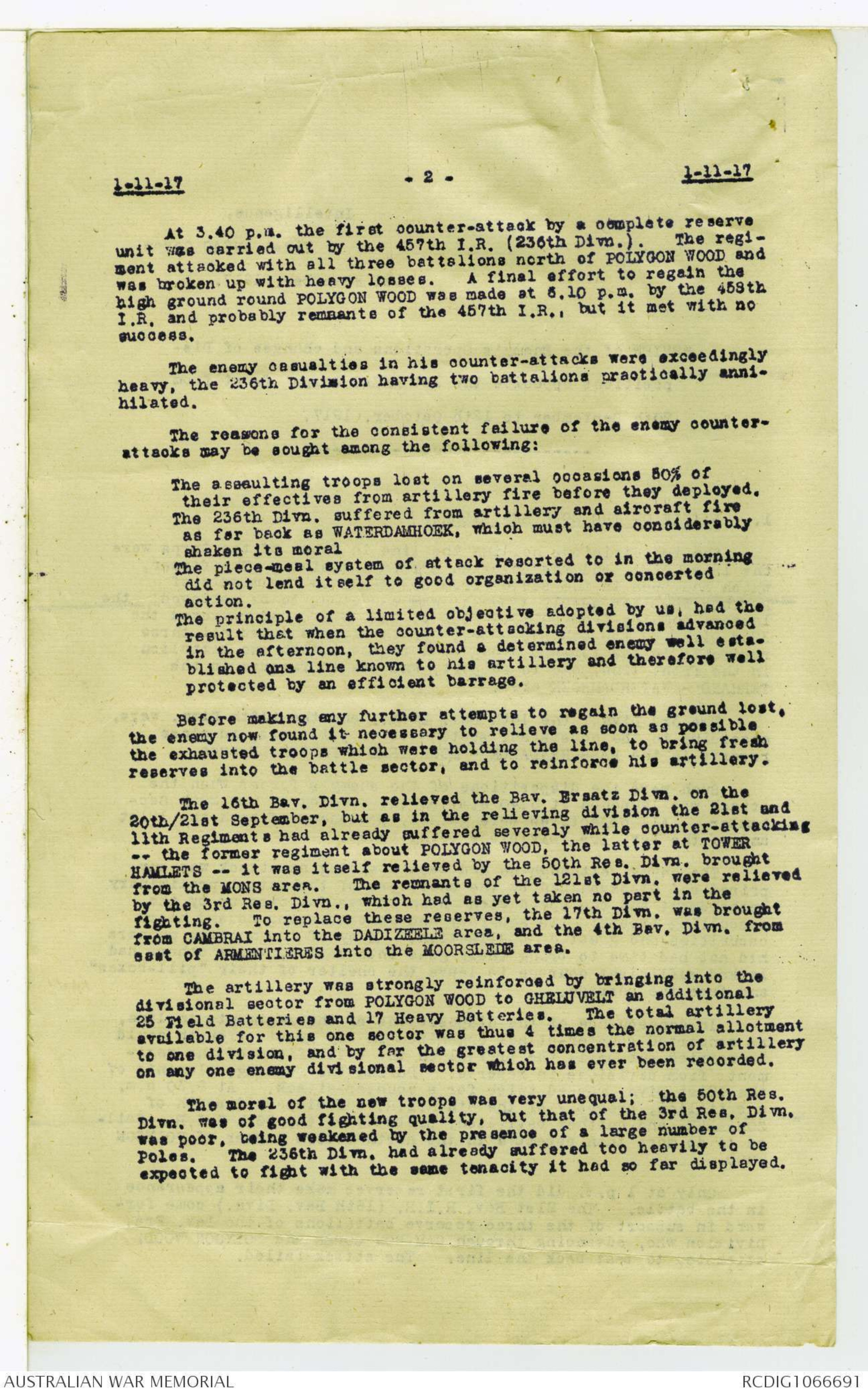

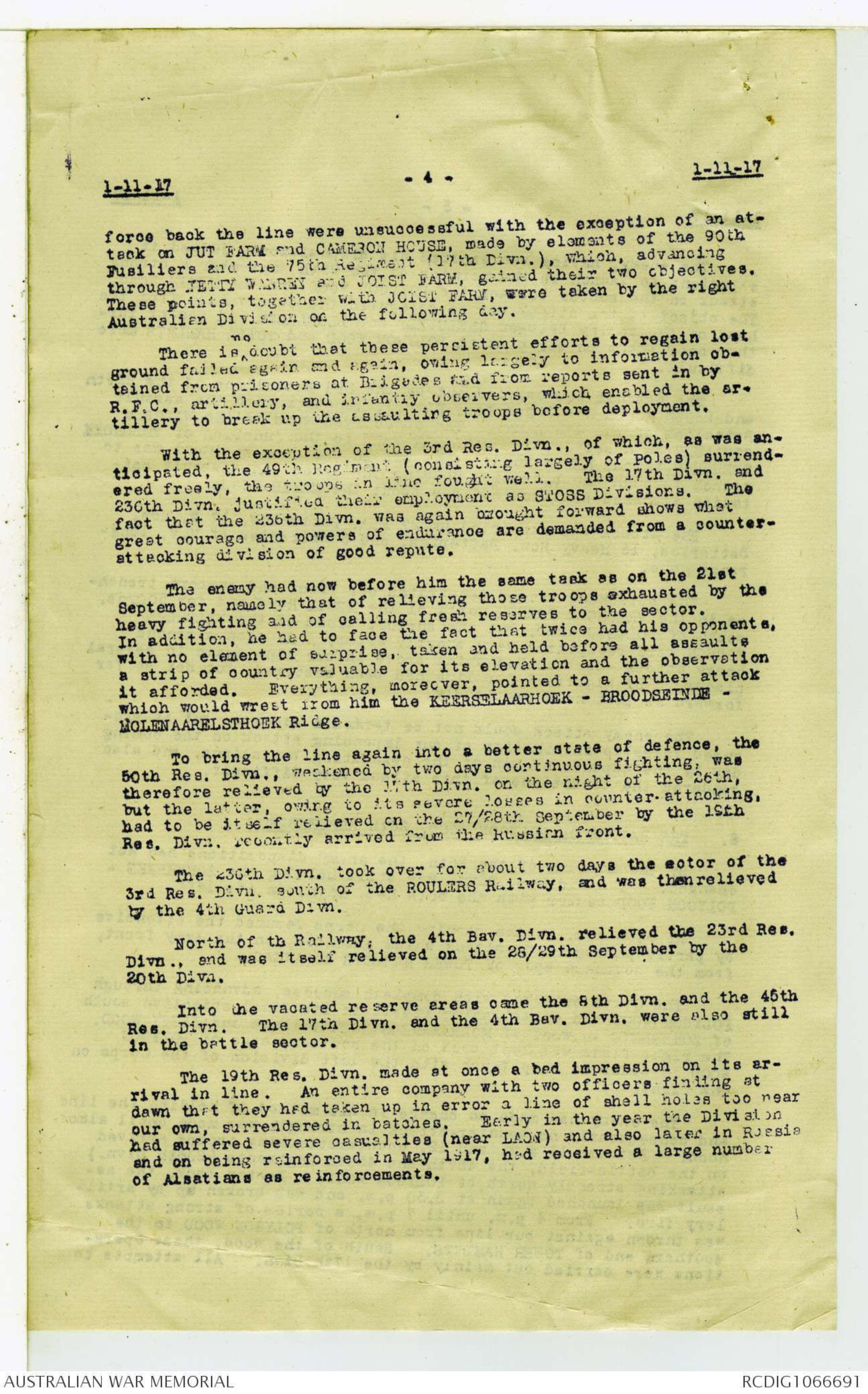
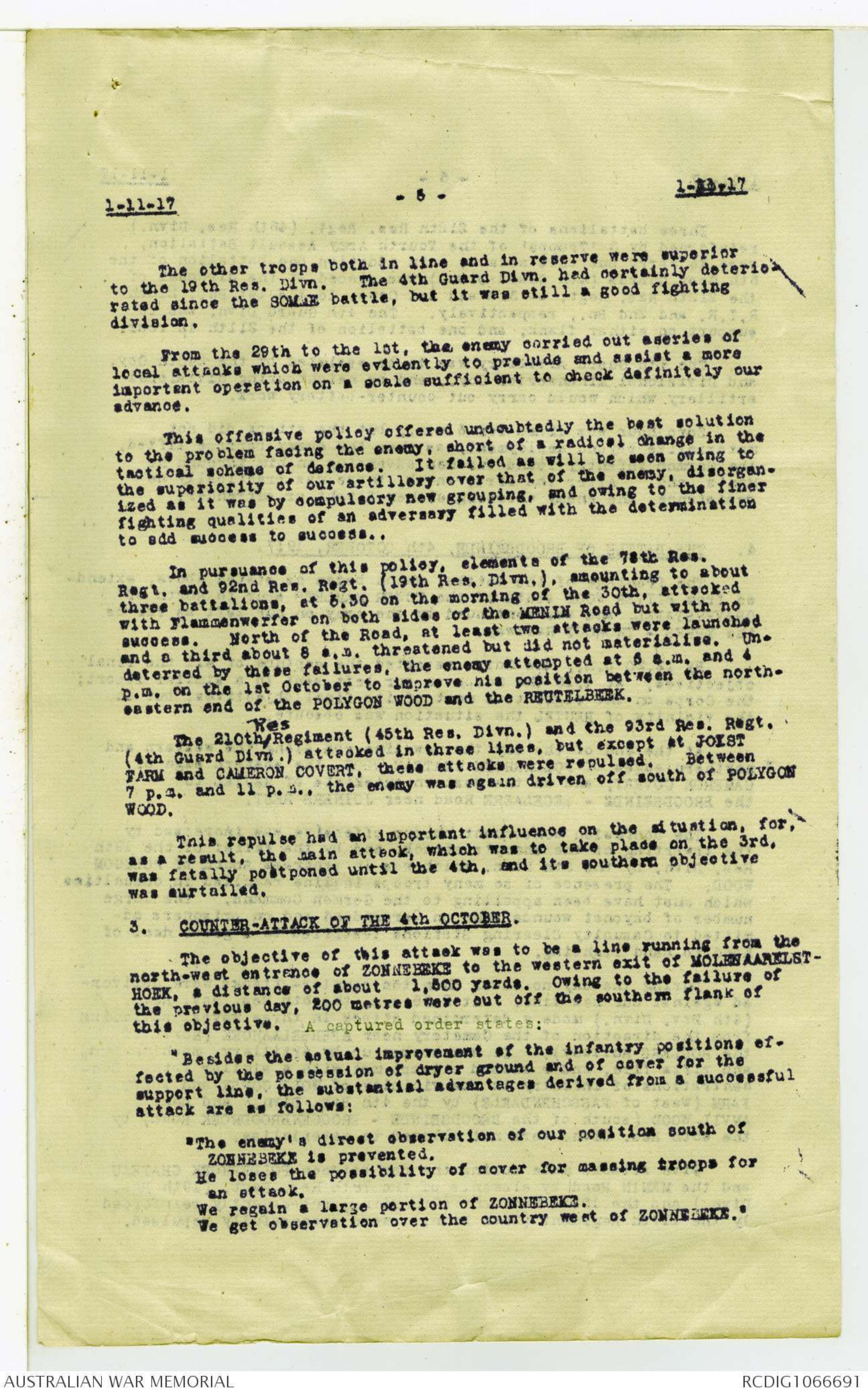
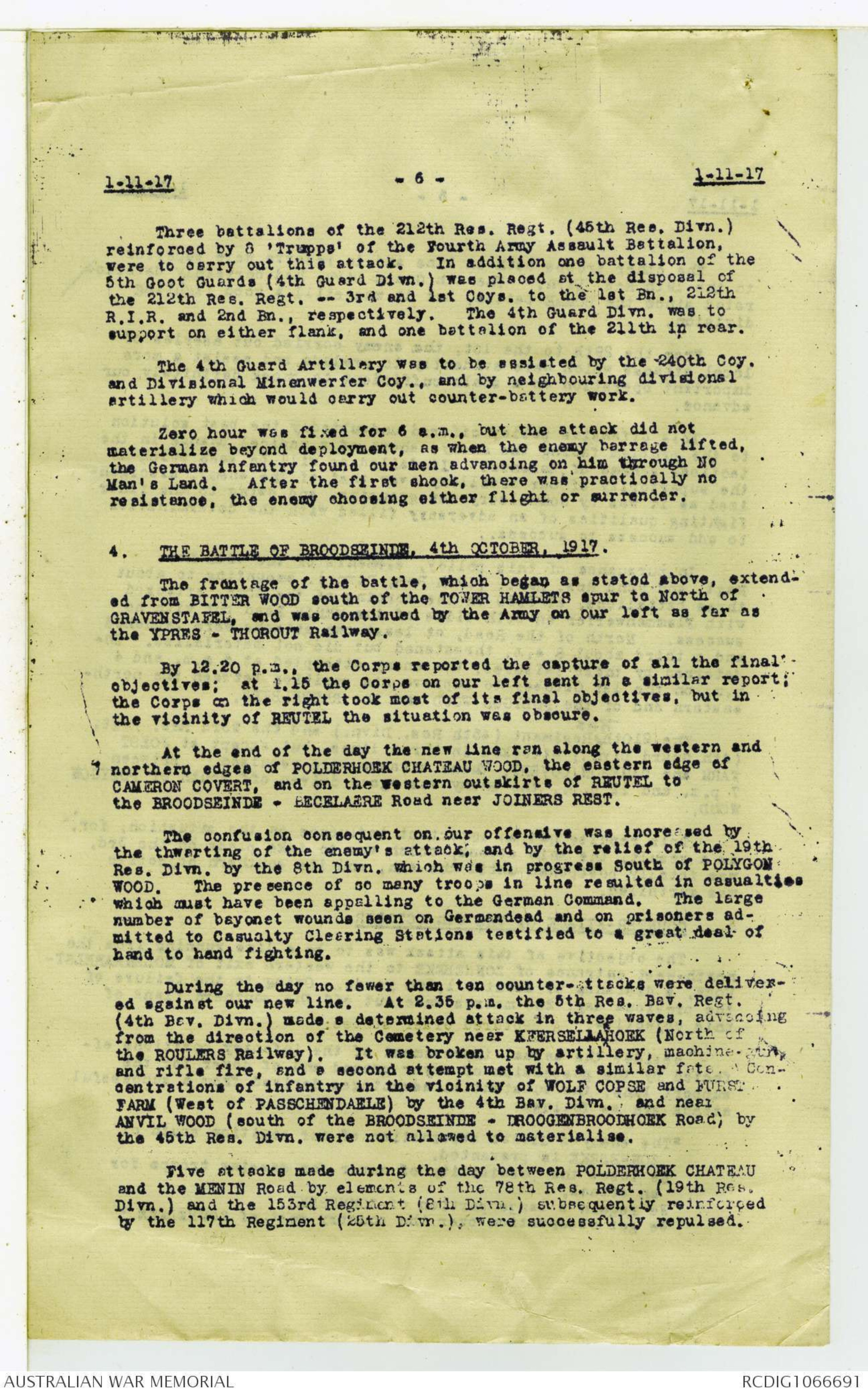

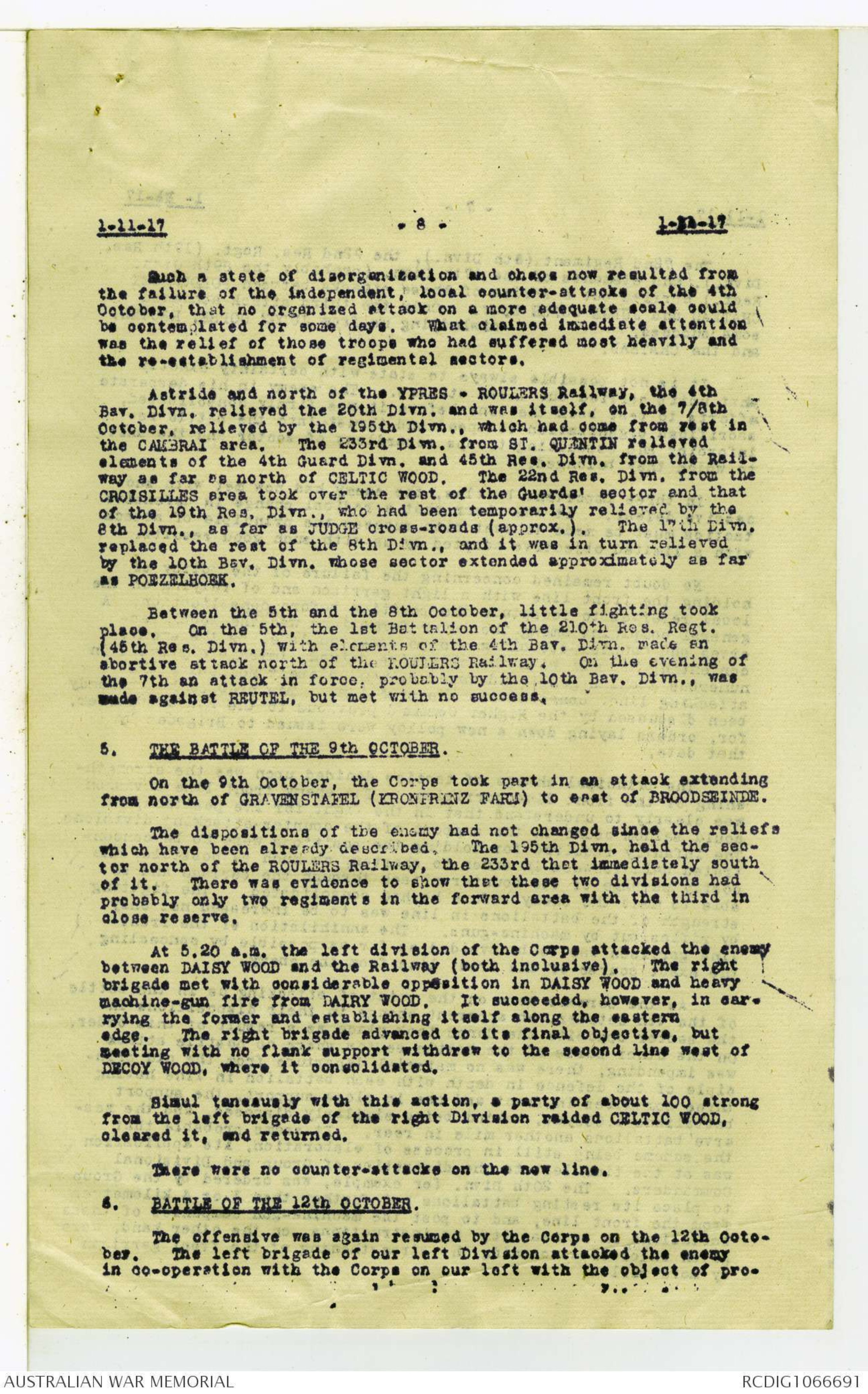
AWM38
Official History,
1914-18 War: Records of C E W Bean,
Official Historian.
Diaries and Notebooks
Item number: 3DRL606/254/1
Title: Folder, 1917 - 1933
Covers the third battle of Ypres, 1917 and
includes copies of records, maps, extracts from
diaries of Pte H G Hartnett and Lt W G Fisher
and letters by J L Treloar, T H E Heyes and Prof
L F Giblin.
AWM38-3DRL606/254/1
[[??]]
3rd Battle of YPRES. 254
1st SET AWM 38
DIARIES AND NOTES OF C. E W. BEAN
CONCERNING THE WAR OF 1914 - 1918
THE use of these diaries and notes is subject to conditions laid down in the terms
of gift to the Australian War Memorial. But, apart from those terms, I wish the
following circumstances and considerations to be brought to the notice of every
reader and writer who may use them.
These writings represent only what at the moment of making them I believed to be
true. The diaries were jotted down almost daily with the object of recording what
was then in the writer's mind. Often he wrote them when very tired and half asleep;
also, not infrequently, what he believed to be true was not so – but it does not
follow that he always discovered this, or remembered to correct the mistakes when
discovered. Indeed, he could not always remember that he had written them.
These records should, therefore, be used with great caution, as relating only what their author, at the time of writing, believed. Further, he cannot, of course, vouch
for the accuracy of statements made to him by others and here recorded. But he
did try to ensure such accuracy by consulting, as far as possible, those who had
seen or otherwise taken part in the events. The constant falsity of second-hand
evidence (on which a large proportion of war stories are founded) was impressed
upon him by the second or third day of the Gallipoli campaign, notwithstanding
those who passed on such stories usually themselves believed them to be true. All
second-hand evidence herein should be read with this in mind.
16 Sept., 1946. C. E. W. BEAN
Capt Bean
Intelligence,
First ANZAC Corps.
1st November, 1917.
REVIEW of the Enemy's Operations and changes of Dispositions
opposite the 1st ANZAC Corps' front from
20th September to 12th October, 1917.
1. BATTLE OF THE 20th SEPTEMBER
The two divisions holding the line in front of the Corps were
the 121st. Divn, and the Bavarian Ersatz Division. The former,
which had been in the sector from ZONNEBEKE to the middle of
POLYGON WOOD for nearly a month, was expecting to be relieved; the
latter, holding from POLYGON WOOD to GHELUVELT, had relieved the
32nd Divn. on the 4th September. Both divisions had all three
regiments in the forward area, each regiment with one battalion
in the front line, one in support, and one in reserve in the
TERHAND - WATERDAMHOEK area.
The 3rd Divn., the 16th Bav. Divn., and the 236th Divn. were,
according to the consistent statements of prisoners, in close
reserve in the PASSCHENDAELE - MOORSUEDE - DADIZEELE area.
Such were the dispositions of the enemy's forces when the
attack was launched at 5.40 a.m. on the morning of the 20th September.
All objectives were gained, prisoners of both the 121st
and of the Bav. Ers. Divisions being taken.
The enemy, although he had been awaiting an attack was surprised
and disorganized by the shortness of the actual preliminary
bombardment and the speed with which it was followed up by the
assaulting troops; its accuracy and concentrating caused heavy
casualties and great demoralisation. Many of the machine gunners
had not had time to bring their guns into action, while others had
lacked sufficient courage to leave the shelter of their "pill-boxes"
and face the barrage.
In consequence of the dispositions of the regiments in line,
no concerted counter-attack organized in any great strength could
be carried out until the arrival on the battlefield of the regiments
from divisions in reserve. During the morning, elements of
the 121st Divn. massed twice for a counter-attack. At 8.30 a.m.
a battalion, probably of the 8th R.I.R. was dispersed south of
ZONNEBKE, and another battalion, probably of the 55th R.I.R., failed
to do more than assemble in the north-eastern corner of POLYGON
WOOD.
Only at 1 p.m. did the first reserves make their appearance
in the battle. The 21st Bav. R.I.R. (16th Bav. Divn.) come forward
in support of the three reserve battalions of the Bav. Ers.
Division who, advancing through CAMERON COPSE and POLYGON WOOD,
attempted to beat back the line. The attack failed.
1-11-17 - 2 - 1-11-17
At 3.40 p.m. the first counter-attack by a complete reserve
unit was carried out by the 457th l.R. (236th Divn.). The regiment
attacked with all three battalions north of POLYGON WOOD and
was broken up with heavy losses. A final effort to regain the
high ground round POLYGON WOOD was made at 6.10 p.m. by the 458th
I.R. and probably remnants of the 457th I.R., but it met with no
success.
The enemy casualties in his counter-attacks were exceedingly
heavy, the 236th Division having two battalions practically annihilated.
The reasons for the consistent failure of the enemy counterattacks
may be sought among the following:
The assaulting troops lost on several occasions 50% of
their effectives from artillery fire before they deployed,
The 236th Divn. suffered from artillery and aircraft fire
as far back as WATERDAMHOEK, which must have considerably
shaken its moral
The piece-meal system of attack resorted to in the morning
did not lend itself to good organization or concerted
action.
The principle of a limited objective adopted by us, had the
result that when the counter-attacking divisions advanced
in the afternoon, they found a determined enemy well established
ona line known to his artillery and therefore well
protected by an efficient barrage.
Before making any further attempts to regain the ground lost,
the enemy now found it necessary to relieve as soon as possible
the exhausted troops which were holding the line, to bring fresh
reserves into the battle sector, and to reinforce his artillery.
The 16th Bav. Divn. relieved the Bav. Ersatz Divn. on the
20th/21st September, but as in the relieving division the 21st and
11th Regiments had already suffered severely while counter-attacking
- - the former regiment about POLYGON WOOD, the latter at TOWER
HAMLETS -- it was itself relieved by the 50th Res. Divn. brought
from the MONS area. The remnants of the 121st Divn. were relieved
by the 3rd Res. Divn., which had as yet taken no part in the
fighting. To replace these reserves, the 17th Divn. was brought
from CAMBRAI into the DADIZEELE area, and the 4th Bav. Divn. from
east of ARMENTIERES into the MOORSLEDE area.
The artillery was strongly reinforced by bringing into the
divisional sector from POLYGON WOOD to GHELUVELT an additional
25 Field Batteries and 17 Heavy Batteries. The total artillery
available for this one sector was thus 4 times the normal allotment
to one division, and by far the greatest concentration of artillery
on any one enemy divisional sector which has ever been recorded.
The moral of the new troops was very unequal; the 50th Res.
Divn. was of good fighting quality, but that of the 3rd Res. Divn.
was poor, being weakened by the presence of a large number of
Poles. The 236th Divn. had already suffered too heavily to be
expected to fight with the same tenacity it had so far displayed.
1-11-17 - 3 - 1-11-17
The enemy, having reorganized his dispositions, judged it
expedient to launch on the morning of the 25th September a strong
attack on the sector between the POLYGON WOOD and the MENIN Road.
The object of the attack was to safeguard the observation from the
head of the valley between GHELUVELT and BECELAERE and render further
operations on our part at POLYGON WOOD and TOWER HAMLETS more
difficult.
The assault was carried out by the 3rd Battalions of the 229th
and 230th Regiments (50th Res. Divn.), together with the assault
Battalion of the 4th Army. The objectives were in the WILHELM
STELLUNC in a sector from CARLISLE FARM to the junction of VELDHOEK
TRENCH with the MENIN Road. The 3rd Bn. of each regiment was to
attack through the battalion holding the line; the Assault Battalion
attacked small objectives about the MENIN Road.
The attack was supported by 27 F.A. Batteries, 17 F. How.
Batteries, 15 Heavy How. Batteries, and 5 batteries of H.V. long-range
guns.
The attacking troops penetrated our front and support trenches
in the VELDHOEK TRENCH north of the MENIN Road and for 500yds,
south of POLYGON WOOD, but the support lines of the VELDHOEK
TRENCH were recaptured very shortly after. At noon a second
heavy attack was launched which drove in our line again in several
places. By nightfall our line had been restored, but not so far
forward as that held previously.
The enemy attack could not be termed a success, but it procured
valuable information of our impending attack on the coming
day by the capture of men of the assaulting battalions, and also
rendered the conditions of this attack very difficult,
2. THE BATTLE OF POLYGON WOOD, 26TH SEPTEMBER.
By the morning of the 26th, the enemy dispositions had not
changed. The 3rd Res. Divn. was still holding the ZONNEBEKE -
POLYGON WOOD sector with the 50th Res. Divn. on its left.
At 5.50 a.m. in the morning the Corps resumed the offensive
by participating in an attack which extended, on the Army front,
from the southern spur of TOWER HAMLETS to ANZAC.
The Corps attacked with complete success, advancing through
POLYGON WOOD and establishing itself in its final objective south
of ZONNEBEKE - - west of MOLENAAREOSSTHOEK Village and JETTY WOOD.
The right flank was kept back on the southern edge of POLYGON
WOOD in order to keep touch with the left division of the Corps on
the right.
The enemy had made no change in his method of holding the line
and consequently no counter-attack in strength was made until almost
noon. Between 11 a.m. and 12, counterattacking troops arrived
on the battle-field, the 457th and 458th Regiments (236th Divn.)
attacking strongly north of POLYGON WOOD. Beaten back, the assault
was launched again at 3.30 p.m. and was broken up by artillery
fire. From 4 p.m. until 7 p.m. a series of strong attacks
was thrown against our line from north of POLYGON WOOD to the
southern end of TOWER HAMLETS. South of the wood, these operations
were carried out mainly by the 17th Divn. All attempts to
1-11-17 - 4 - 1-11-17
force back the line were unsuccessful with the exception of an attack
on JUT FARM and CAMERON HOUSE, made by elements of the 90th
Fusiliers and the 75th Regiment (17th Divn.), which, advancing
JETTY WARREN and JOIST FARM, gained their two objectives.
These points, together with JOIST FARM, were taken by the right
Australian Division on the following day.
There is ^no doubt that these persistent efforts to regain lost
ground failed again and again, owing largely to information obtained
from prisoners at Brigades and from reports sent in by
R.F.C., artillery, and infantry observers, which enabled the artillery
to break up the assaulting troops before deployment.
With the exception of the 3rd Res. Divn., of which, as was anticipated,
the 49th Regiment (consisting largely of Poles) surrendered
freely, the troops in line fought well. The 17th Divn. and
the 236th Divn. justified their employment as STOSS Divisions. The
fact that the 236th Divn. was again brought forward shows what
great courage and powers of endurance are demanded from a counter-attacking
division of good repute.
The enemy had now before him the same task as on the 21st
September, namely that of relieving those troops exhausted by the
heavy fighting and of calling fresh reserves to the sector.
In addition, he had to face the fact that twice had his opponents,
with no element of surprise, taken and held before all assaults
a strip of country valuable for its elevation and the observation
it afforded. Everything, moreover, pointed to a further attack
which would wrest from him the KEERSELAARHOEK - BROODSEINDE
MOLENAARELSTHOEK Ridge.
To bring the line again into a better state of defence, the
50th Res. Divn., weakened by two days continuous fighting, was
therefore relieved by the 17th Divn. on the night of the 26th,
but the latter, owing to its severe losses in counter-attacking,
had to be itself relieved on the 27/28th September by the 19th
Res. Divn. recently arrived from the Russian front.
The 236th Divn. took over for about two days the sector of the
3rd Res. Divn, south of the ROULERS Railway, and was then relieved
the 4th Guard Divn.
North of the Railway, the 4th Bav. Divn. relieved the 23rd Res.
Divn., and was itself relieved on the 28/29th September by the
20th Divn.
Into the vacated reserve areas came the 8th Divn. and the 45th
Res. Divn. The 17th Divn. and the 4th Bav. Divn. were also still
in the battle sector.
The 19th Res. Divn. made at once a bad impression on its arrival
in line. An entire company with two officers finding at
dawn that they had taken up in error a line of shell holes too near
our own, surrendered in batches. Early in the year the Division
had suffered severe casualties (near LAON) and also later in Russia
and on being reinforced in May 1917, had received a large number
of Alsatians as reinforcements.
1-11-17 - 5 - 1-11-17
The other troops both in line and in reserve were superior
to the 19th Res. Divn. The 4th Guard Divn. had certainly deteriorated
since the SOMME battle, but it was still a good fighting
division.
From the 29th to the 1st, the enemy carried out a series of
local attacks which were evidently to prelude and assist a more
important operation on a scale sufficient to check definitely our
advance.
This offensive policy offered undoubtedly the best solution
to the problem facing the enemy, short of a radical change in the
tactical scheme of defence. It failed as will be seen owing to
the superiority of our artillery over that of the enemy, disorganized
as it was by compulsory new grouping, and owing to the finer
fighting qualities of an adversary filled with the determination
to add success to success. .
In pursuance of this policy, elements of the 78th Res.
Regt. and 92nd Res. Regt. (19th Res. Divn.), amounting to about
three battalions, at 5.30 on the morning of the 30th, attacked
with Flammenwerfer on both sides of the MENIN Road but with no
success. North of the Road, at least two attacks were launched
and a third about 8 a. m. threatened but did not materialise. Undeterred
by these failures, the enemy attempted at 6 a.m. and 4
p.m. on the 1st October to improve his position between the north-eastern
end of the POLYGON WOOD and the REUTELBEEK.
The 210th ^Res Regiment (45th Res. Divn.) and the 93rd Res. Regt.
(4th Guard Divn.) attacked in three lines, but except at JOIST
FARM and CAMERON COVERT, these attacks were repulsed. Between
7 p.m. and 11 p.m., the enemy was again driven off south of POLYGON
WOOD.
This repulse had an important influence on the situation, for,
as a result, the main attack, which was to take place on the 3rd,
was fatally postponed until the 4th, and its southern objective
was curtailed.
3. COUNTER-ATTACK OF THE 4th OCTOBER.
The objective of this attack was to be a line running from the
north-west entrance of ZONNEBEKE to the western exit of MOLENAARELSTHOEK,
a distance of about 1,500 yards. Owing to the failure of
the previous day, 200 metres were cut off the southern flank of
this objective. A captured order states:
"Besides the actual improvement of the infantry positions effected
by the possession of dryer ground and of cover for the
support line, the substantial advantages derived from a successful
attack are as follows:
"The enemy' s direct observation of our position south of
ZONNEBEKE is prevented.
He loses the possibility of cover for massing troops for
an attack.
We regain a large portion of ZONNEBEKE.
We get observation over the country west of ZONNEBEKE."
1-11-17 - 6 - 1-11-17
Three battalions of the 212th Res. Regt. (45th Res. Divn.)
reinforced by 8 'Trupps' of the Fourth Army Assault Battalion,
were to carry out this attack. In addition one battalion of the
5th Goot Guards (4th Guard Divn.) was placed at the disposal of
the 212th Res. Regt. -- 3rd and 1st Coys. to the 1st Bn., 212th
R.I.R. and 2nd Bn., respectively. The 4th Guard Divn. was to
support on either flank, and one battalion of the 211th in rear.
The 4th Guard Artillery was to be assisted by the 240th Coy.
and Divisional Minenwerfer Coy., and by neighbouring divisional
artillery which would carry out counter-battery work.
Zero hour was fixed for 6 a.m., but the attack did not
materialize beyond deployment, as when the enemy barrage lifted,
the German infantry found our men advancing on him through No
Man's Land. After the first shock, there was practically no
resistance, the enemy choosing either flight or surrender.
4. THE BATTLE OF BROODSEINDE, 4th OCTOBER, 1917.
The frontage of the battle, which began as stated above, extended
from BITTER WOOD south of the TOWER HAMLETS spur to North of
GRAVENSTAFEL, and was continued by the Army on our left as far as
the YPRES - THOROUT Railway.
By 12.20 p.m., the Corps reported the capture of all the final
objectives; at 1.15 the Corps on our left sent in a similar report;
the Corps on the right took most of its final objectives, but in
the vicinity of REUTEL the situation was obscure.
At the end of the day the new line ran along the western and
northern edges of POLDERHOEK CHATEAU WOOD, the eastern edge of
CAMERON COVERT, and on the western outskirts of REUTEL to
the BROODSEINDE - BECKLAERE Road near JOINERS REST.
The confusion consequent on our offensive was increased by
the thwarting of the enemy's attack, and by the relief of the 19th
Res. Divn. by the 8th Divn. which was in progress South of POLYGON
WOOD. The presence of so many troops in line resulted in casualties
which must have been appalling to the German Command. The large
number of bayonet wounds seen on Germandead and on prisoners admitted
to Casualty Clearing Stations testified to a great deal of
hand to hand fighting.
During the day no fewer than ten counter-attacks were delivered
against our new line. At 2.35 p.m. the 5th Res. Bav. Regt.
(4th Bav. Divn.) made a determined attack in three waves, advancing
from the direction of the Cemetery near KEERSELLAHOEK (North of
the ROULERS Railway). It was broken up by artillery, machine-gun,
and rifle fire, and a second attempt met with a similar fate. Concentrations
of infantry in the vicinity of WOLF COPSE and FURST
FARM (West of PASSCHENDAELE) by the 4th Bav. Divn, and near
ANVIL WOOD (south of the BROODSEINDE - DROOGENBROODHOEK Road) by
the 46th Res. Divn. were not allowed to materialise.
Five attacks made during the day between POLDERHOEK CHATEAU
and the MENIN Road by elements of the 78th Res. Regt. (19th Res.
Divn.) and the 153rd Regiment (8th Divn.) subsequently reinforced
the 117th Regiment (25th Divn.), were successfully repulsed.
1-11-17 - 7 - 1-11-17
The 72nd Regiment (8th Divn.), the 92nd Res. Regt. (19th Res.
Divn.), and elements of the 17th Divn. (probably the 89th Gren.
Regt.) carried out a series of these attacks between POLDERHOEK
CHATEAU and JUDGE COPSE Spur. Only the third attack achieved
some success, dislodging us from JUDGE COPSE, REUTEL,
and the CHATEAU.
It is not possible always to state with certainty exactly
what units carried out these attacks. The enemy in his desperate
efforts to beat back the line before it was firmly consolidated,
sacrificed organization to speed and thrust into the battle reinforcing
and assaulting troops regardless of sector and the unit
to which they belonged.
In three important battles, the enemy had now met with successive
defeat. It was clear that a radical change in defensive
tactics must be made to meet with success the principle of attack
with a limited objective adopted by us with such good results.
No doubt remained concerning the failure of the policy of
holding the front line with a light garrison and of relying on the
local reserves to recapture the position before consolidation. A
general complaint among the lower formations was ^that the local reserves
and counter-attacking troops came too late, as the enemy,
contenting himself with the objective gained, immediately built in
numerous machine-guns, and waves of men, closely following the
attacking line, consolidated the position. The problem had already
been discussed by the Higher Command previous to the 2nd of October,
for, orders laying down a new policy were issued to Brigades by
that date.
The principal change of tactics decided upon was the strengthening
of the front line garrision. The enemy front line division
was clearly to understand that in the fight for is position, it
could seldom count on the support of the counter-attacking divisions.
The infantry required for holding the positions were to be concentrated
well forward in order to shorten, as much as possible, the
costly passage of the counter-attack through the barrage and be
able to meet the enemy before he had consolidated. The fighting
strength of the battalions in line was to be increased not only
by rifles but by machine-guns. The annihilation of the front
line garrison was to be avoided as far as possible by concealing,
the exact course of the front line from the enemy.
As the Germans were on the point of attacking us in the battle
of the 4th October, no apparent change in their dispositions in
the sector opposite the Corps took place as a result of this order.
On the other parts of the battle sector where no hostile attack
was impending, there was no material departure from the old principle
of the defence in depth with each battalion in line having
three companies in front and one in close support, the support
battalions 1,000yds, behind being similarly disposed, and the reserve
battalions another mile in rear. It seems probable that
the scheme being still in process of elaboration, its application
was at the time left to the discretion of Group and Divisional
Commanders. The 20th Divn. for example, was ordered by the Group
to place its resting battalions not further than 3 or 4 kilometres
from the front line, and to post the machine-gun companies of these
battalions, in or near it; no instructions, on the other hand, were
given in ^the order concerning the strengthening of the front garrison
by more rifles.
1-11-17 - 8 - 1-11-17
Such a state of disorganization and chaos now resulted from
the failure of the independent, local counter-attacks of the 4th
October, that no organized attack on a more adequate scale could
be contemplated for some days. What claimed immediate attention
was the relief of those troops who had suffered most heavily and
the re-establishment of regimental sectors.
Astride and north of the YPRES - ROULERS Railway, the 4th
Bav. Divn, relieved the 20th Divn., and was itself, on the 7/8th
October, relieved by the 195th Divn., which had come from rest in
the CAMBRAI area. The 233rd Divn. from ST. QUENTIN relieved
elements of the 4th Guard Divn. and 45th Res. Divn, from the Railway
as far as north of CELTIC WOOD. The 22nd Res. Divn. from the
CROISILLES area took over the rest of the Guards' sector and that
of the 19th Res. Divn., who had been temporarily relieved by the
8th Divn., as far as JUDGE cross-roads (approx.). The 17th Divn.
replaced the rest of the 8th Divn., and it was in turn relieved
by the 10th Bav. Divn. whose sector extended approximately as far
as POEZELHOEK.
Between the 5th and the 8th October, little fighting took
place. On the 5th, the 1st Battalion of the 210th Res. Regt.
(46th Res. Divn.) with elements of the 4th Bav. Divn. made an
abortive attack north of the ROULERS Railway. On the evening of
the 7th an attack in force, probably by the 10th Bav. Divn. was
made against REUTEL, but met with no success,
5. THE BATTLE OF THE 9th OCTOBER.
On the 9th October, the Corps took part in an attack extending
from north of GRAVENSTAFEL (KRONPRINZ FARM) to east of BROODSEINDE.
The dispositions of the enemy had not changed since the reliefs
which have been already described. The 195th Divn. held the sector
north of the ROULERS Railway, the 233rd that immediately south
of it. There was evidence to show that these two divisions had
probably only two regiments in the forward area with the third in
close reserve.
At 5.20 a.m. the left division of the Corps attacked the enemy
between DAlSY WOOD and the Railway (both inclusive). The right
brigade met with considerable opposition in DAlSY WOOD and heavy
machine-gun fire from DAIRY WOOD. It succeeded, however, in carrying
the former and establishing itself along the eastern
edge. The right brigade advanced to its final objective, but
meeting with no flank support withdrew to the second line west of
DECOY WOOD, where it consolidated.
Simultaneausly with this action, a party of about 100 strong
from the left brigade of the right Division raided CELTIC WOOD,
cleared it, and returned.
There were no counter-attacks on the new line.
6. BATTLE OF THE 12th OCTOBER.
The offensive was again resumed by the Corps on the 12th October.
The left brigade of our left Division attacked the enemy
in co-operation with the Corps on our left with the object of pro-.....
 Sandy Mudie
Sandy MudieThis transcription item is now locked to you for editing. To release the lock either Save your changes or Cancel.
This lock will be automatically released after 60 minutes of inactivity.